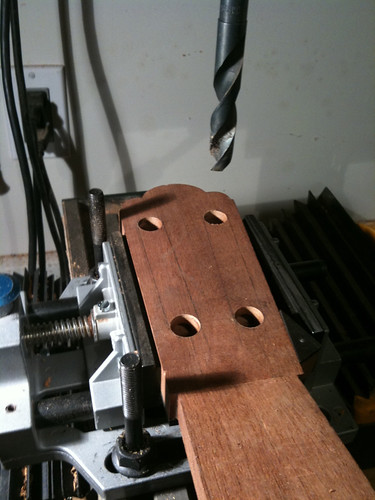The outline shape was first scribed onto the ebony from a template. I then cut out the rough shape on the bandsaw, making sure to cut out the nails used as positioning pins during gluing.
Then I planed the sides down to the marked template outline, giving the headstock its final taper.
I made a simple drilling jig out of acrylic (glued with super/crazy glue) to ensure accurate spacing and positioning for the tuner holes. I drilled the holes on my drill press after clamping the jig to the back of the headstock and holding the entire setup on its side in a vise.
The tuners I am using are Gotoh Hauser style tuners which I got from stewmac.com. A similar style is available from LMI, but they had black plastic buttons instead of real ebony for the same price.
After enlarging the holes slightly (10mm rollers will not fit in 10mm holes) to ensure a comfortable fit I pushed the tuners into place to see how things looked.
At this point I had already marked the position of the slots on the front and back of the headstock using dividers/compass, square and straightedge.
The top and bottom of the two slots were drilled out with a 14mm drill bit. The slot is 16mm wide, leaving 1mm clearance/room for error.
To ensure accurate drilling, I positioned the drill press and pre-drilled starter holes using a centre-drill. This helps stop the large bit from wandering when starting the hole.
I put tape on the ebony side, which was face down during drilling, to help prevent chipping and tearout. Ebony is quite brittle so this could have been quite messy. The tape and some sacrifice plywood underneath seemed to do the trick.
Once the four holes were drilled, I used a framesaw (which can be disassembled and reassembled inside a trapped hole) to connect them and roughly form the slots. It was quite difficult to cut a nice straight line like this, I think I need more practice.
Here you can see the first slot roughly completed. You can also see that the top of the headstock has been finished to its final shape. This shaping was done entirely with a file and small thing sanding sticks/wedges.
Here is the progress so far. The slots still need to be fine finished, and the bottom carved into a ramp. I'll show the finished headstock in the next post.

















